Owl aboard
In southeast Minnesota, a live-wire named Alice inspired an annual festival.
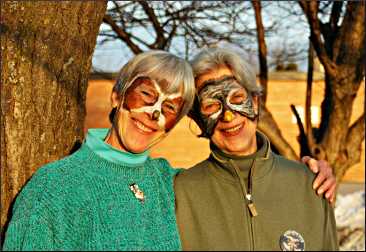
© Torsten Muller
Like most women who take care of small creatures, Karla Bloem splits her life into two parts: Before Alice and After Alice.
Before Alice, Bloem could sleep late and travel whenever she felt like it.
But then little Alice came along. Alice wakes her up at the crack of dawn, sulks if she leaves her and leaves messes all over the house. Alice is a spoiled brat, Karla Bloem admits.
But she can't call Supernanny for help, because Alice is a great horned owl.
When Alice was 3 weeks old, she was blown out of her nest in Antigo, Wis., breaking her left wing at the joint and permanently damaging nerves.
Marge Gibson, who runs a raptor rehabilitation center in Antigo, took Alice in and then gave her to Bloem, who was looking for an injured bird to feature at the Houston Nature Center.
"Fortunately, Alice wasn't afraid of humans," said Bloem. "When Marge came, she ran straight toward her as if to say, 'Here I am, help me.' So Marge knew she'd be a good education bird."
She's been an education for Bloem, that's for sure. Alice lived in an outdoor pen at first but gradually worked her way into Bloem's house.
She thinks Bloem is her mate and, during mating season, expects to hoot with her, nose to beak, for at least an hour a day.
She also wants her to play, never mind the sharp beak and eight talons, and she likes to groom Bloem's face.
"She thinks she's one of us, not an owl, but she still has all the basic owl instincts," the naturalist says. "Sometimes she looks at me as if to say, 'Don't you get it?' I'm slowly learning."
Before she retired, Alice commuted to work at the nature center. She has a lot of personality, and she was a big hit in the bluff-country hamlet of Houston, known to bicycle tourists as the eastern trailhead of the Root River State Trail.
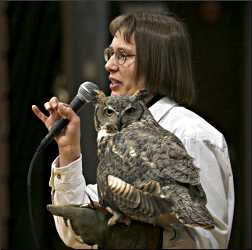
© Alan Stankevitz
So when Alice turned 6, Bloem started the Festival of Owls to celebrate her hatch-day.
Every year, the festival has gotten a little bigger, drawing an irruption of owl-fanciers from around the nation. Now, Houston has an International Owl Center in a storefront downtown, with Bloem as director.
There are plenty of owls to see at the town's owl festival. The year I went, it started with a talk by David Johnson, a native Minnesotan who now is director of the Global Owl Project. He'd flown in from Virginia to speak about owls in lore and culture.
"They're a powerful bird," he said. "In central Australia, owls are considered Creator beings. The Dakota thought they had the power to cure wounds. They're associated with shamans on Mayan ruins, and they're on Greek coins from 600 B.C."
Then the first owl was inducted into the Owl Hall of Fame. It was Fat Broad, the Oregon spotted owl who became the poster owl of the logging controversy.
Eric Forsman, the U.S. Forest Service biologist who was her handler until her death, teared up when he accepted her award.
"I had her for 32 years; I was 23 when I took her out of the nest," he said. "Fat Broad ate like a big pig and she was always overweight, so a neighbor dubbed her for the character in the "B.C." comic strip. She was a great ambassador for her species."
Owls inspire many emotions in people. They're the only animals besides primates that have flat faces with eyes in the middle, but they're not particularly smart; their eyes and ears fill so much space there's not much room for brain.
They're quite a piece of machinery, though.
Their head can swivel 270 degrees on a long and flexible neck, and a great gray can hear a mouse when the mouse is buried under 18 inches of snow.
A little rustle will reach its forward ear a split second before the rear ear, allowing its brain to calculate when it should pounce.
They're also very good at eating what they catch, even if the prey is half their size. Duluth ornithologist Laura Erickson has seen a great horned eat a whole gray squirrel, ratcheting it down bit by bit, and a 4-ounce saw-whet down a mouse.
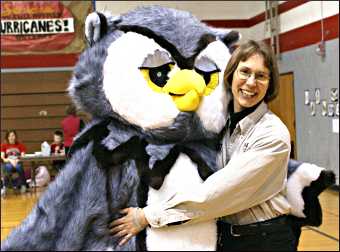
© Lisa Wadley
"Its esophagus is stretchy like a balloon," she says. "They have an hourglass stomach. The mouse goes into the top part, the part with acid, and that changes the mouse into mouse soup, with bones and teeth and hair floating around like noodles. The gizzard squeezes out the good soup part, and once a day the owl spits out a pellet with the rest."
Erickson led the festival's Saturday-morning dissection of owl pellets, which Bloem likens to "a box of Cracker Jacks; you don't know what kind of prize you'll find in the bottom."
One woman found a cowbird skull in her pellet. I found only bits of vole skeletons in my ball of compressed fur, though I could see that one of them was a tiny thigh bone, nestled perfectly into a pelvic joint.
There's no point in being delicate about bodily functions where owls are concerned. From the dissection, I went to see the video "At Home With Alice," in which Karla Bloem gives "the Top 10 reasons you don't want an owl for a pet."
They include "an unending stream of poop" and "food preparation every night of your life as long as you own an owl."
In Bloem's case, that means thawing and gutting a pocket-gopher carcass to give to Alice, who then caches the leftovers around the house in spots that Bloem sometimes doesn't find until they start to rot.
In the afternoon, there was an owl meet-and-greet hosted by Marge Gibson.
We met Malcolm the barred owl, with no ear tufts but huge dark eyes — "if our eyes were that big, they'd be the size of grapefruits," Gibson said — and Pepe Lulu the barn owl, with the white face that often gets barn owls mistaken for a ghost.
There was Oscar the long-eared owl, and two Eastern screech owls, Watson and Wookie, whose wide-open eyes under straight-up ear tufts gave them a highly caffeinated look.
The tiniest owl was Little Bit the northern saw-whet, a fearsome predator that looks like a cuddly ball of fluff.
"Now we all say, 'Aww, cute,' " Gibson told the crowd.
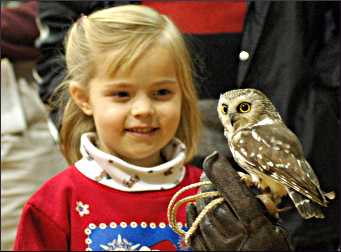
© Torsten Muller
In the evening, everyone got onto buses and went on an owl prowl with either Laura Erickson or raptor expert Mike Furr of Coon Valley, Wis.
"They've both had owls land on their shoulders," Bloem says. "If you heard them in the woods, you wouldn't have any idea they're not an owl."
In early March, many owls have just started breeding, so it's a good time to try to call them in. The screech owl has a whinny that sounds a little like a loon, and the saw-whet toots steadily, like a truck backing up.
The long-eared owl sounds like a dog's "woof," without the "f," and the barn owl shrieks like an angry cat.
It's the barred owl that makes the classic call "who cooks for you." But when Furr tried to call it in on our first stop, only a dog responded.
"That's a bark owl," he quipped.
We kept our eyes peeled because we weren't likely to hear the owls, whose flight is silenced by special feathers that muffle the sound of air rushing over the surface of the wing.
"On one Elderhostel, I called and 17 minutes later, one answered 2 feet over our heads," Furr said. "Some people practically jumped out of their skins; no one had heard it."
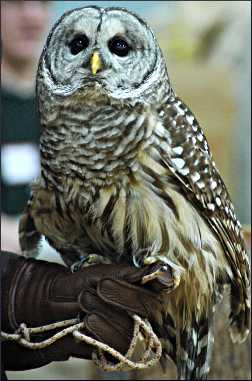
© Torsten Muller
On our next stop, a barred owl responded, but Furr suspected it was Laura Erickson, calling on the other side of the Root River.
Finally, we went to Karla Bloem's farmhouse, because she said she often hears the calls of screech and saw-whet owls in the woods.
But all we called in was a cow, which contributed a well-timed "moo."
We could see Alice on her perch inside the house, regarding us as regally as a queen.
"She's so chock full of personality," Bloem says. "I have no doubt she's the most spoiled-rotten great horned owl in the world."
Trip Tips: International Festival of Owls
Getting there: Houston is about three hours southeast of the Twin Cities and half an hour west of La Crosse.
When: It's held the first weekend of March.
Events: A button is required for activities at Houston High School, including owl prowls, storytelling, crafts, Alice's hatch-day party, live-owls programs and an owl-calling contest.
Register in advance for events that charge additional fees, including photography sessions, the banquet and the birding bus trip with German lunch. The owl-pellet dissection and owl nest-box building require extra fees but not pre-registration.
**International Owl Center: The center offers programs that are popular at the festival, including pellet dissection and owl prowls.
It also has five ambassador owls: Uhu, a Eurasian eagle owl; Ruby, a great horned owl; Piper, an American barn owl; JR, an Eastern screech owl; and Bea, a burrowing owl. Alice stays home these days.
Admission is $7, $4 for children 4-17. From fall to spring, it's open Friday through Monday, with programs at 11 a.m. and 2 p.m.
Accommodations: Loken's Sawmill Inn & Suites in Houston is a very pleasant place to stay. Loken's Rushford Inn is 12 miles away in Rushford.
Outside town, Money Creek Retreat rents three cabins.
La Crosse, a half-hour east of Houston, has many places to stay.
For more, see Cruising La Crosse.
Owl-watching elsewhere: For more about owls from the northern forests, see Owls, owls, everywhere.